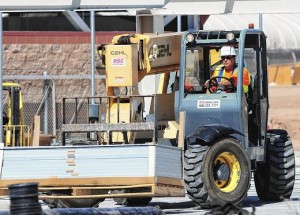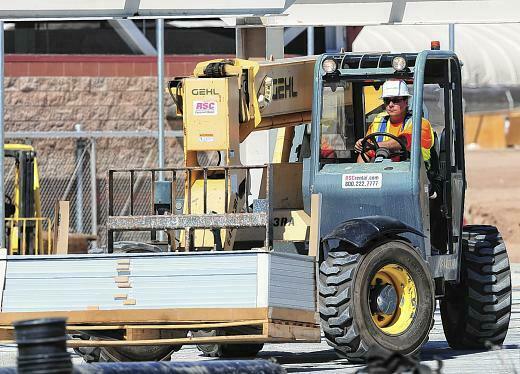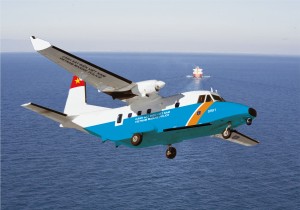With the F-35B Joint Strike Fighter scheduled to begin arriving in phases later this fall, Marine Corps Air Station Yuma has been a very busy place the past two years as it has prepared for its new aircraft, pilots and crews.
Lt. Col. John Hicks, airfield operations officer, said there has been about 24 construction projects at MCAS Yuma the past two years totaling $350 million. While most are strike fighter-related, such as squadron hangars, some are not.
“We have a lot of projects right now that are completed, or on the verge of completion. Some of the projects aren’t as visible, but they are just as important,” Hicks said. “The footprint of the air station hasn’t changed all that much, but the capabilities have been vastly improved.”

Those projects, however, are only the first two rounds of airfield construction and renovation being done at the air station as it continues to modernize. In total, as much as $500 million could be allotted to the air station by 2015, including $100 million in 2013. Some future projects over the next three years include a Security Operations building, and new Combat Aircraft Loading apron.
“There are things going on at this base that we have been trying to get done for quite some time,” Hicks said. “Some of the projects get picked up faster than others, based on their operational impact, but we are always going to be thinking about the next phase.”
Among the already-completed and near-completed projects are two new hangars, which cost about $38 million each. While the hangars have specifically been designed for the F-35B, Hicks said they can still be used to maintain other aircraft if needed.
“We have three more hangars coming, two of which are designed for the F-35, and one that is a universal, meaning that it is designed for any type of squadron,” Hick said. “With that there is going to be some demolition involved.”
The first JSF hangar was occupied on Aug. 20 by Marines attached to the first F-35B Squadron, designated as the VMFA-121, who are known as the Green Knights. Until recently the squadron had been based at MCAS Miramar and flew the F/A-18D.
Hicks said VMA-121 is expected to get its first F-35s on Nov. 20, and should have an entire squadron of planes by late spring or early summer. The next squadron to receive its new planes will be VMA-211, which lost six of its Harrier jets during an insurgent attack in September in Afghanistan.
“It’s going to take some time. We are talking about hundreds of millions of dollars of aircraft,” Hicks said. “It just takes time to build these things. They are very complicated, very detailed aircraft. It is not the World War II days when they could crank out a hundred in a day. It takes a lot more time than it did before.”
As the future home of the first F-35 fighters in the country, MCAS Yuma will get five squadrons each with 16 aircraft, and one operational test and evaluation squadron of eight aircraft. These 88 aircraft will replace Yuma’s four existing squadrons of 56 AV-8B Harriers
The conversion will take several years, meaning the Yuma community will have the privilege of seeing both airplanes in action together for the foreseeable future.
Hicks went on to say that the third and fourth hangars are currently in design with construction expected to be completed in May 2014. The fifth JSF hangar, he said, has not been awarded yet, but the base expects to demolish two of the older fixed-wing hangars and replace them with the fifth F-35 hangar within the next five years.Also as part of the build-up, construction on an Intermediate Maintenance Activity building and a F-35 Simulator Facility were recently completed.
“Those are kind of the big visible changes around the air station,” Hicks said.While its construction wasn’t as apparent, Hicks said it was also extremely important to upgrade the air station’s utilities and communication capabilities to ensure it had the power resources to support the F-35 program’s infrastructure needs.
“Some of that stuff hasn’t been done in decades,” Hicks said. “These buildings are all running off of a grid or infrastructure that was designed in the 50s and 60s that just isn’t able to keep up with it anymore. It’s not something you will see a lot of construction for, other than dug up streets, that type of stuff.”
Construction is also under way on a new Field-Carrier Landing Practice training facility that is being built on the Barry M. Goldwater Range. The project, which was awarded in June, is expected to be completed by July 2013.“They are already out there working now,” Hicks said.
The new field-carrier landing facility will simulate the deck of an amphibious assault ship where pilots can practice their carrier landings. It will have a paved airfield, flight control tower, air operation facility, fire and rescue shelter, aircraft fueling areas, aircraft maintenance shelter and vertical take-off and landing pads.
By James Gilbert
The YumaSun




